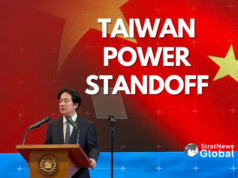The India-China relationship remains in a state of limbo, with efforts to normalise ties moving at a frustratingly slow pace. Manoj Kewalramani, Chairperson of Indo-Pacific Studies Programme at Takshashila Institution, highlights that despite some people-centred efforts like visa talks and religious pilgrimages re-opening, both sides are digging in. “We’ve been normalising ties for 2,000 years,” a former diplomat once said to him, underlining the point that normalisation will be slow, fragmented, and never guaranteed, especially given structural tensions like rising power competition and massive asymmetries in economic, military, and technological strength.
‘A SIGH OF CONFIDENCE, NOT VULNERABILITY’
Kewalramani rejects the idea that China’s aggressive moves are due to domestic political instability. He argues that Xi Jinping’s position is stronger than ever, having consolidated power and carried out sweeping anti-corruption campaigns even against top-ranking officials. “That’s not a signal of vulnerability- it’s a sign of confidence,” he notes. The real motivation behind China’s assertiveness lies in its strategic thinking. Xi’s focus is on preparing for extreme scenarios, testing the limits of what it can get away with, and calibrating power projection accordingly.
ALIGNING CHINA TO XI’S SECURITY-FIRST AGENDA
China’s new white paper on national security is a case in point. Far from a novel doctrine, Kewalramani sees it as a consolidation of a decade’s worth of thinking. It outlines a holistic approach- where everything from food and trade to technology and even culture is framed through a security lens. The goal, he says, is primarily domestic: to force China’s fragmented bureaucracy to align around Xi’s security-first agenda. This will likely lead to more laws, tighter controls, and a system that prioritises regime security over economic growth.
IS IT TIME FOR INDIA TO SHED ITS CHINA TRADE FEARS?
Turning to India-China trade, Kewalramani argues for a nuanced view. “All dependencies aren’t bad,” he says. “The key is identifying where a dependency turns into a vulnerability.” Strategic sectors like APIs (active pharmaceutical ingredients) or digital infrastructure need de-risking, but sectors like toys may simply need Indian manufacturers to step up. Rather than an emotional boycott of Chinese goods, Kewalramani urges calibrated, sector-specific action and stresses that trade, when balanced, can act as a stabiliser even in tense geopolitical climates.
‘STRATEGIC AUTONOMY CUTS BOTH WAYS’
India’s broader China strategy, he suggests, must combine diplomacy with leverage. That means deepening defence partnerships, building influence in China’s periphery, and working with like-minded powers like the U.S., Japan, and France. Kewalramani also warns against over-reliance on values-driven diplomacy. “Strategic autonomy cuts both ways,” he says. Countries act in self-interest. India must do the same – counter where needed, cooperate where possible, and prepare where vulnerabilities exist.
FOR BEIJING, PAKISTAN NOT NECESSARILY A TRUSTED PARTNER…
Manoj Kewalramani offers a sharp perspective on the China-Pakistan relationship, calling it largely instrumental and transactional. While often portrayed as an ‘all-weather friendship,’ he argues that China’s view of Pakistan is highly strategic. Beijing sees Islamabad as a useful lever against India, not necessarily a trusted partner. This relationship is rooted in China’s desire to constrain India’s rise and divert its strategic attention. For China, Pakistan is a tool to keep India engaged in subcontinental affairs, rather than expanding its influence more broadly in the Indo-Pacific. Kewalramani notes that while India worries about the China-Pakistan axis, it must not overplay its threat. “China will support Pakistan to the extent it serves its interests,” he implies—suggesting that New Delhi should focus more on building resilience and influence, rather than being reactive to Beijing’s tactical partnerships.
“WHEN HOSTILITY SEEPS INTO PUBLIC IMAGINATION…”
Finally, he points out a worrying shift in Chinese public perception. Surveys show rising hostility toward India, in contrast to older, more neutral views. Textbooks now reference Galwan and 1962, and anti-India sentiment is growing. Kewalramani sees this as a calculated change in state messaging. “When hostility seeps into public imagination, it’s harder to walk back,” he warns, making the case for more engagement, not less, to prevent long-term entrenchment of mistrust.
To watch the detailed interaction with Manoj Kewalramani on tensions, trade and trust deficit in the context of India, China and other global players, click here.




